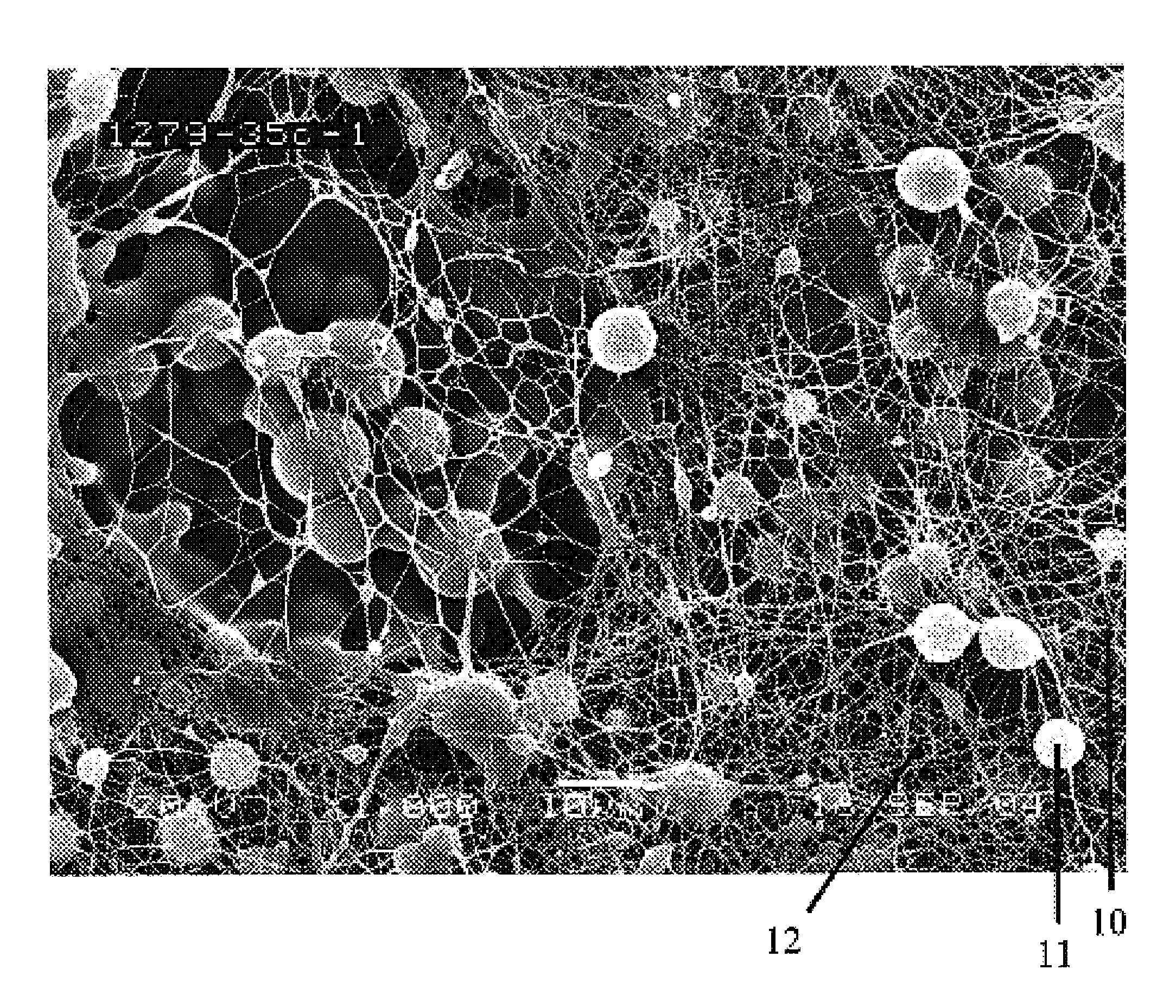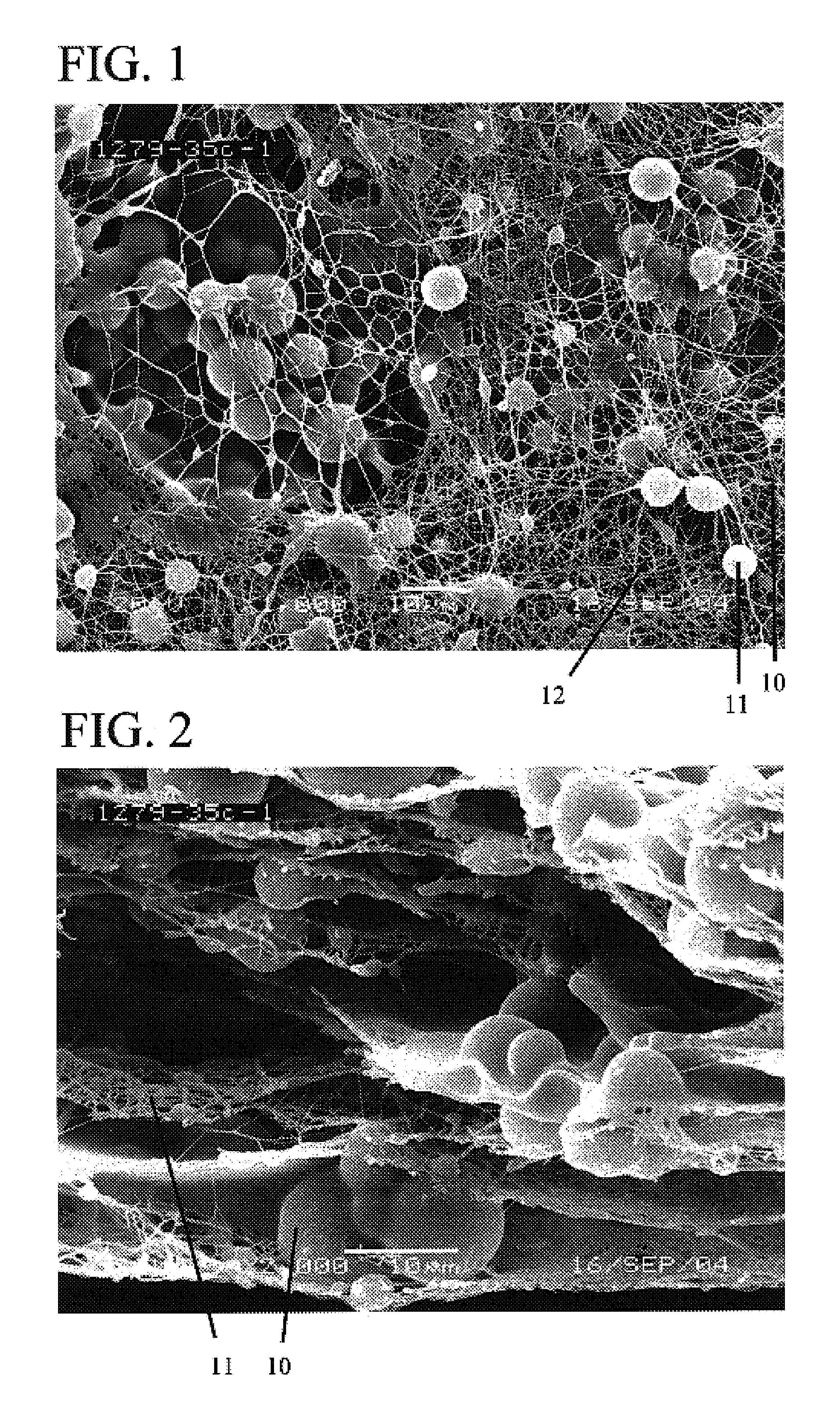Reduced solidity web comprising fiber and fiber spacer or separation means
a solidity web and fiber technology, applied in the field of webs or fiber structures, can solve the problems of reducing efficiency, affecting the internal workings of various mechanisms, and incorporating material into fibers, and achieves the effect of reducing the amount of material on the substrate and measurable filtration efficiency
- Summary
- Abstract
- Description
- Claims
- Application Information
AI Technical Summary
Benefits of technology
Problems solved by technology
Method used
Image
Examples
example 1
[0099]The run cycle for this 1× sample was:
[0100]
3 minElectrospinning of nylon solution and blend of polymersolution simultaneously (all four stations)+2 minOnly electrospinning of nylon solution (only Stations 2and 3)
[0101]This has the same amount of nanofibers as Example 2 (total amount of a nanofiber spinning is 5 minutes-1×-); however because there is no particle in this media and hence the solidity of the media is greater, and the air permeability is lower than Example 2. The media was heated to 300° F. for 10 minutes in a lab oven in an attempt to mimic any changes in fiber morphology that may take place with the heat treatment of Example 2.
example 2
[0102]The run cycle for this 1× sample was:
[0103]
1 minElectrospinning of nylon solution and blend of polymersolution simultaneously (all four stations)+2 minElectrospinning of nylon solution and blend of polymersolution simultaneously and deposition of SP-500 nylonmicrospheres (all four stations)+2 minOnly electrospinning of nylon solution (only Stations 2and 3)
[0104]The total run time to generate this sample took 5 minutes. Amount of SP-500 nylon microspheres discharged was 9.5 g. The media was heated to 300° F. for 10 minutes in a lab oven in an attempt to increase the bond strength between electrospun fibers and microspheres. After that, 4 inch diameter samples were cut and tested on TSI 3160 fractional efficiency test bench.
example 3
[0105]The run cycle for this 1.6× sample was:
[0106]
6 minElectrospinning of nylon solution and blend of polymersolution simultaneously (all four stations)+2 minOnly electrospinning of nylon solution (only Stations 2and 3)
[0107]This has the same amount of nanofibers as Example 4 (total amount of nanofiber spinning is 8 minutes-1.6×-); however because there is no particle in this media and hence the solidity of the media is greater, and the air permeability is lower than Example 4. The media was heated to 300° F. for 10 minutes in a lab oven in an attempt to mimic any changes in fiber morphology that may take place with the heat treatment of Example 4.
PUM
| Property | Measurement | Unit |
|---|---|---|
| particle size | aaaaa | aaaaa |
| thickness | aaaaa | aaaaa |
| diameter | aaaaa | aaaaa |
Abstract
Description
Claims
Application Information
 Login to View More
Login to View More - R&D
- Intellectual Property
- Life Sciences
- Materials
- Tech Scout
- Unparalleled Data Quality
- Higher Quality Content
- 60% Fewer Hallucinations
Browse by: Latest US Patents, China's latest patents, Technical Efficacy Thesaurus, Application Domain, Technology Topic, Popular Technical Reports.
© 2025 PatSnap. All rights reserved.Legal|Privacy policy|Modern Slavery Act Transparency Statement|Sitemap|About US| Contact US: help@patsnap.com



